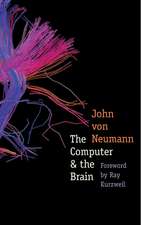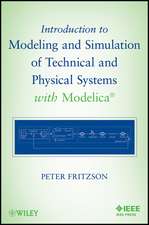Organization Structure: Cybernetic Systems Foundation: IFSR International Series in Systems Science and Systems Engineering, cartea 22
Autor Yasuhiko Takahara, Mihajlo Mesarovicen Limba Engleză Paperback – 27 aug 2012
Din seria IFSR International Series in Systems Science and Systems Engineering
- 18%
 Preț: 955.70 lei
Preț: 955.70 lei - 18%
 Preț: 951.91 lei
Preț: 951.91 lei - 18%
 Preț: 1391.21 lei
Preț: 1391.21 lei - 18%
 Preț: 955.56 lei
Preț: 955.56 lei -
 Preț: 387.58 lei
Preț: 387.58 lei - 20%
 Preț: 994.73 lei
Preț: 994.73 lei - 18%
 Preț: 1132.33 lei
Preț: 1132.33 lei - 15%
 Preț: 637.59 lei
Preț: 637.59 lei - 15%
 Preț: 640.24 lei
Preț: 640.24 lei - 20%
 Preț: 989.79 lei
Preț: 989.79 lei - 18%
 Preț: 947.67 lei
Preț: 947.67 lei - 18%
 Preț: 953.03 lei
Preț: 953.03 lei - 15%
 Preț: 643.84 lei
Preț: 643.84 lei - 18%
 Preț: 1109.92 lei
Preț: 1109.92 lei - 20%
 Preț: 501.42 lei
Preț: 501.42 lei - 18%
 Preț: 1116.26 lei
Preț: 1116.26 lei -
 Preț: 399.29 lei
Preț: 399.29 lei - 20%
 Preț: 644.48 lei
Preț: 644.48 lei -
 Preț: 391.40 lei
Preț: 391.40 lei - 15%
 Preț: 646.62 lei
Preț: 646.62 lei - 19%
 Preț: 447.26 lei
Preț: 447.26 lei -
 Preț: 388.52 lei
Preț: 388.52 lei - 18%
 Preț: 792.03 lei
Preț: 792.03 lei - 15%
 Preț: 648.42 lei
Preț: 648.42 lei - 18%
 Preț: 786.36 lei
Preț: 786.36 lei -
 Preț: 520.08 lei
Preț: 520.08 lei - 15%
 Preț: 643.00 lei
Preț: 643.00 lei
Preț: 386.61 lei
Nou
Puncte Express: 580
Preț estimativ în valută:
73.98€ • 77.24$ • 61.23£
73.98€ • 77.24$ • 61.23£
Carte tipărită la comandă
Livrare economică 05-19 aprilie
Preluare comenzi: 021 569.72.76
Specificații
ISBN-13: 9781461379447
ISBN-10: 146137944X
Pagini: 284
Ilustrații: 288 p.
Greutate: 0.38 kg
Ediția:2003
Editura: Springer Us
Colecția Springer
Seria IFSR International Series in Systems Science and Systems Engineering
Locul publicării:New York, NY, United States
ISBN-10: 146137944X
Pagini: 284
Ilustrații: 288 p.
Greutate: 0.38 kg
Ediția:2003
Editura: Springer Us
Colecția Springer
Seria IFSR International Series in Systems Science and Systems Engineering
Locul publicării:New York, NY, United States
Public țintă
ResearchCuprins
1 Organizational Cybernetics.- 1.1 Traditional Systems View of Organization.- 1.2 Management Cybernetics: A Viable System Model.- 1.3 General Systems Theoretic View of Complex System: Multi-layer Model.- 1.4 Model of Organizational Cybernetics.- 2 Goal Seeking System.- 2.1O rganization Member as Goal Seeking System.- 2.2 Decision Problem.- 2.3 Decision Principle and Formal Representation of Goal Seeking System.- 2.4 Input Output Model Associated With Goal Seeking System: Standard Operating Procedure.- 3 Goal Compatibility.- 3.1 Goal Compatibility in Decision Principle.- 3.2 Goal Compatibility Example: Political Desirability of Decision Principle.- 3.3 Required Properties for Decision Principle.- 4 Organization Skeleton.- 4.1 Hierarchical Skeleton of Organization.- 4.2 Taxonomy of Organization.- 4.3 Properties of Organization Chart.- 5 Operational Level Management.- 5.1 Regulation of Operational Level.- 5.2 Stability of Operational Level.- 5.3 Departmentalized Operational Units.- 5.4 Optimization Activity of Operational Level.- 6 Organizational Level Management.- 6.1 Total Scheme of Organizational Level Management.- 6.2 Formulation of Organizational Level Management.- 6.3 Example of Formulation.- 6.4 Coordination Principle and Design of Organizational Level Management.- 7 Goal Assignment Coordination.- 7.1 Organizational Level Management Structure on IBP (Interaction Balance Principle).- 7.2 Intra-level Function for IBP Coordination.- 7.3 Validity Theorem of Operational Goal Assignment Coordination.- 7.4 Operational Level Goal Design for IBP.- 8 Task Assignment Coordination.- 8.1 Organizational Level Management Structure in Coordination by IPP.- 8.2 Example of Organizational Level Management Structure on IPP.- 8.3 Validity Theorem of Operational Task Assignment.- 9 Normative Behavior Model Of Operational Level.- 9.1 Normative Operational Level Model.- 9.2 Formulation of Normative Operational Unit and Optimal Directive.- 9.3 Management Structure of Normative Model.- 9.5 Feasibility of Normative Management.- 10 Institutional Level Management.- 10.1 External Input Structure and Institutional Level Management.- 10.2 Structure.- 10.3 Internal Model Principle.- 10.4 Environmental Variety and Internal Variety.- 10.5 Variety Matching.- 11 Computational Approach To Organization.- 11.1 Computational Approach to Organization Theory.- 11.2 Garbage Can Model.- 11.3 Formulation of Garbage Can Model.- 11.4 Implementation of Garbage Can Model.- Appendix I General Sytems Approach and General Systems Models.- AI.1 Introduction.- AI.2 Development Methodology and General Systems Model.- AI.3 Characterization.- AI.4 Categorization.- AI.5 Universality.- Appendix II Min-Max Theorem.- AII.1 Introduction.- AII.2 Preliminary Concepts.- All.3 Optimization and Min-max Theorem.- AII.4 Min-max Theorem for Differentiable Function.- AII.5 Min-max Theorem.- Appendix III Maximum Principle.- AIII.1 Introduction.- AIH.2 Maximum Principle.- References.














